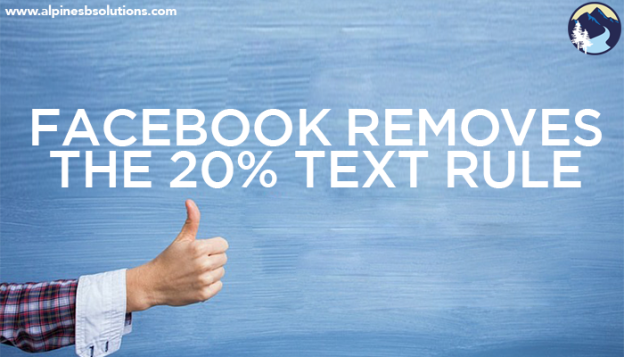To the joy of marketers everywhere, Facebook finally altered the 20% text rule! This recent change will provide more flexibility and freedom to marketers, while likely impacting the ad experience for Facebook users. Below we break down some common questions about this recent change.
What was the rule before the change?
 Previously, Facebook rejected ad requests where more than 20% of the image contained text. This caused frustration among marketers whose ads were rejected for containing just barely too much text, and for brands whose logo was text. Some arguably creative and effective ads were also rejected due to containing too much text.
Previously, Facebook rejected ad requests where more than 20% of the image contained text. This caused frustration among marketers whose ads were rejected for containing just barely too much text, and for brands whose logo was text. Some arguably creative and effective ads were also rejected due to containing too much text.
Why did this rule exist if it caused so much frustration?
Facebook, as it repeatedly claims, is all about the user experience. Part of the user experience is the appearance and feel of the timeline. The line of thinking from Facebook went something like this… if ads appeared on timelines containing massive amounts of text, the timelines would appear cluttered and users would be less satisfied with the look of their timelines. Preventing advertisers from using too much text also helped push advertisers to make more creative ads that focused on “showing” rather than “telling,” since you rely on words to “tell.”
So with this change, can I now use as much text as I want on ads?
 Marketers are now given the option to use photos in their ads that contain more than 20% text. No longer will beautiful ads be rejected for containing just a little bit too much text-marketers rejoice! The new change means Facebook will not stop advertisers from using an image simply because of an abundance of text (other restrictions, such as inappropriate images, still apply). However, Facebook still is pursuing the user experience as the priority. While it removed the “stick” form of motivation (punishing users for ads with too much text by preventing those ads from being published), it simultaneously implemented a “carrot” approach of motivation (providing an incentive to still use ads with minimal text). So even though it may not be a requirement, they still are going to make sure marketers keep limiting text at the top of their minds.
Marketers are now given the option to use photos in their ads that contain more than 20% text. No longer will beautiful ads be rejected for containing just a little bit too much text-marketers rejoice! The new change means Facebook will not stop advertisers from using an image simply because of an abundance of text (other restrictions, such as inappropriate images, still apply). However, Facebook still is pursuing the user experience as the priority. While it removed the “stick” form of motivation (punishing users for ads with too much text by preventing those ads from being published), it simultaneously implemented a “carrot” approach of motivation (providing an incentive to still use ads with minimal text). So even though it may not be a requirement, they still are going to make sure marketers keep limiting text at the top of their minds.
So, why would I still want to use ads with minimal text?
First, ads with too much text are not visually appealing. They make the photo appear cluttered and busy, two things you want to avoid because viewers will likely skip over it. Of course, there are exceptions where the cluttered and busy look is used to make a creative point, but generally speaking it’s a good idea to limit text from a graphic design standpoint.
 Second, using too much text will negatively affect the amount of people who see your ad. Facebook has said that, given the same budget, ads with more text will reach a lower number of individuals than ads with less text. Hence the carrot again. They will motivate you to do what they like by giving you more views. Facebook won’t stop you from using too much text, but it makes it clear it is in the best interest of the marketer to continue using minimal text.
Second, using too much text will negatively affect the amount of people who see your ad. Facebook has said that, given the same budget, ads with more text will reach a lower number of individuals than ads with less text. Hence the carrot again. They will motivate you to do what they like by giving you more views. Facebook won’t stop you from using too much text, but it makes it clear it is in the best interest of the marketer to continue using minimal text.
How will I know if my ad still uses too much text?
Images uploaded for ads will be placed into one of four categories. The one marketers should aim for is “image text: OK” because it will see no negative impact on reach. These photos contain no or minimal text. The next category “image text: low” sees a slightly limited ad reach. The third category “image text: medium” may see limited ad reach. The fourth category “image text: high” may not even reach the intended audience at all. When advertisers upload a photo in the grid tool, Facebook will let the user know which category the photo falls into.

